Is your grass not as green as it was? Have your flowers stopped blooming? They are common questions people have this time of year.
Horticulturist Jerry Goodspeed from the Utah State University Extension answers gardener’s biggest questions.
1. Why is my lawn brown and my neighbors green?
A. lawns are the number one problem and we get the most questions about. Things to check: Depth of watering, uniformity of sprinklers, dig in the soil and look for worms, and if all else fails, bring in a sample to the USU diagnostic clinics in your county.
2. Do I still need to spray my apples to prevent worms?
A. Yes. We have two to three generations each year. Go to http://utahpests.usu.edu/ where we post when and what to spray to protect your fruit.
3. How do I get my annuals to look as good as they did a month ago, before it got so hot?
Move them to Northern Montana… Actually, apply a water soluble fertilizer every couple of weeks. This will supply a little extra fertilizer to give them a little boost coming out of the summer.
4. What causes my tree to ooze and get foamy from different spots?
A. This is called slime flux or Bacterial Wetwood. Very common in willow, poplar, some maple, mulberry, and elm trees. Really nothing you can do for it since it is an internal disease. Most trees will simply live with the problem. It may kill a couple. You can clean up the tree with a Clorox solution (10%)
5. How do I control earwigs?
A. Earwigs like to spend the day in cool damp places and come out in the night and invade the home, chew on plants, steal old Chevy’s, and just cause problems. Control them by limiting places where they spend the day. You can also create places for them to move into, such as rolling up old newspapers or cardboard baited with oatmeal or bran, or tuna cans with a little bacon grease in the shade. Set these out at night and then collect them and throw them away in the morning. Chemically, Sevin (Carbaryl) pyrethrins, or malathion work very well.
6. Why are my Quaking aspen dying?
A. Because they are Quakies and that’s what quakies do… Most quakies in a landscape are considered short lived. They like the cool mountains (well, who doesn’t). There are a number of problems that affect quaking aspens, these include leaf spot, bores, cytospera and other diseases, and iron chlorosis. This is why they grow in clumps, so when one dies, you don’t notice it. Keep the quakies as healthy as possible by keeping them out of the lawn, allowing them to grow in clumps, and don’t overwater them (remember where they grow naturally).
7. How much should I be watering my evergreen trees?
A. Give them a deep drink every two to three weeks. Most lawns are watered quite shallow. Allow a hose to dribble a little water around their base for a few hours so you get a good deep soaking.
8. Why did my petunias stop blooming?
A. Just lucky… Probably the tobacco budworm. It will eat the buds of the flowers before they bloom. Apply a Bt (Bacillus thuringiensis) product, such as Dipel, Thuricide, others. You can also use
Spinosad (Success, Natural Guard, Entrust, others).
9. How much fertilizer should I put down on my lawn when it is so hot? And will it burn my lawn?
A. Actually, we don’t recommend much fertilizer, if any in July and August. Most of our cool season lawns want to slow down and too much fertilizer can do more harm than good. Wait and apply the fertilizer around the first part of September, when the cooler weather allows for good root growth. Then apply about 1 pound of nitrogen per 1,000 sq. ft. (follow label instructions) and it won’t burn the lawn.
10. How do you know when a winter squash is ripe?
a. When their stems go hard and dry. Be patient and allow them to complete mature. Push you fingernail into the stem, if no droops of water form, it is dry.















Add comment